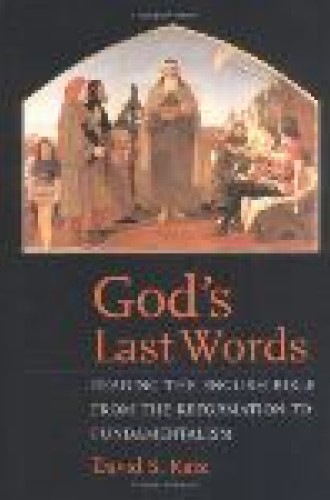God's Last Words: Reading the English Bible from the Reformation to Fundamentalism
One of the comical moments in the early history of printing occurred in 1631, when the English printer Robert Barker produced an edition of the scriptures which became known as the “Wicked Bible.” This edition contained a misprint of the seventh commandment. One thousand copies were printed and ready for publication before someone noticed that the commandment had been changed to “Thou shalt commit adultery.” Nothing much came of it. The printer was fined, the copies destroyed and the moral fiber of the nation remained intact.
But what happens when the verse at issue is not merely a printer’s error but an ancient interpolation into an even more ancient text? Such was the case with 1 John 5:7, the biblical proof-text for the doctrine of the Trinity. Erasmus, Sir Isaac Newton and John Locke, among others, challenged the text’s authenticity. When Erasmus left the verse out of the first edition of his monumental Greek New Testament (1516), he was roundly criticized for encouraging heresies, schisms and conflicts. Erasmus’s critics knew that approaching the Bible in a scholarly fashion was dangerous; even the most pious attempts at rational understanding of scripture could result in skepticism or atheism. How can one appraise the Bible critically and still maintain its authority?
In his engaging and very thorough book, David Katz explores the ways this question was addressed in England from the Reformation onward. A professor at Tel Aviv University, Katz is the author of The Jews in the History of England, 1485-1850 and a host of books and articles on early-modern skepticism and religion. In God’s Last Words, Katz maintains that every era responds to the Bible differently based on shifting cultural assumptions, and he examines the “lens through which the Bible was read” in various historical moments. While Reformation leaders accepted the transparency of the Bible’s message, by the late 17th century this view could no longer be maintained, Katz states.
During the 18th century the Bible came to be regarded as just another literary text—one which increasingly had to conform to contemporary standards of realism. As Darwin’s theories became widely known, 19th-century readers applied an evolutionary model to the Bible and began to see it as the product of a primitive mentality very different from their own. These new ways of reading the Bible seemed to destroy its authority completely until the fundamentalist movement reasserted the old Protestant belief in the Bible’s sole authority.
Throughout the book, Katz emphasizes that what began as pious attempts to understand scripture almost always led to a diminution of biblical authority. Counter-Reformation theologians predicted as much; if one gives the Bible to all to interpret, they argued, everyone will disagree and skepticism will ensue. Katz cites many instances of this paradox. In the 17th century pious Christians attempted to prove the accuracy of biblical chronology. When different theologians came up with conflicting chronologies, the reputation of the texts suffered. In the 19th century scholars tried to verify biblical “quantities,” but the more they attempted to make sense of the Old Testament’s population numbers, the more incredible many biblical events came to seem.
The most provocative part of Katz’s argument is his contention that American fundamentalism represents a return to the Protestant doctrine of sola scriptura. The comparison is apt. The belief in the literal authority of the Bible animating 17th-century prophecies based on the Book of Revelation also underlies today’s enormously popular Left Behind series of “prophetic” novels. But the comparison should not be carried too far. Fundamentalism is a contemporary movement that reacts against the secularism and individualism of the modern world; it is not merely a rebirth of sola scriptura. Katz’s final chapter on fundamentalism is the shortest in the book, and its brevity unfortunately does not allow him to explore fully the complicated relationship of the movement to early Protestantism or its theological nuances.
Katz’s book is notable for its exhaustiveness. In excruciating detail, Katz discusses almost everyone who ever participated in or commented on the various translations of the Bible, and in the course of doing so he considers many of the major thinkers and movements of the past 500 years. This exhaustiveness is both the book’s chief glory and a stumbling block requiring the reader to wade through the minutiae of countless obscure controversies.
The Bible saturates even our secular society. One has only to think of the many biblical allusions in President Bush’s speeches, the recent controversy over former Alabama Chief Justice Roy Moore and the Ten Commandments monument, or the scriptural debate over gay marriage to see that the status of the Bible is still a highly vexing cultural issue. Katz’s book allows us to see biblical controversies in historical context and affords us important insight into the ways the Bible has transformed, and been transformed by, Western culture.





